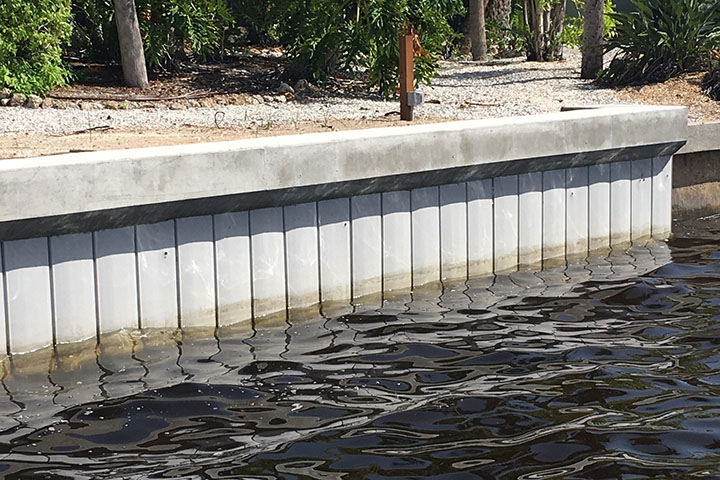Land erosion and storm surges are an ever-growing concern for homeowners and businesses with locations near the ocean. Seawall structures protect your property from eroding into the sea and are an investment that, when built properly, can offer years of protection. With a variety of materials to choose from, deciding on the best option is important. Since most seawalls are built of either concrete precast panels or vinyl, this article will discuss the pros and cons of these two material options.
Purchasing the proper materials to construct your seawall is based on a variety of variables that include:
- geographical location
- soil type
- neighborhood construction allowances
- city ordinances
- space for construction equipment
Which Type of Seawall is Better: Concrete or Vinyl?
Concrete
The Pros
Concrete Seawalls are strong, have a flat surface and can often last more than 30 years. The key to a strong concrete seawall is the reinforcing steel it contains. Without this reinforcing steel, the wall will quickly fail. The key to getting a long service life from a concrete seawall is to protect the reinforcing steel from the corrosive marine environment. In a conventional concrete wall this protection is provided by the concrete cover.
The Cons
Even the best concrete walls will require ongoing maintenance to protect them from the natural damage that will occur due to exposure from salt-water and ocean elements. This maintenance will usually consist of repairs to seawall cracks and holes. In addition, salt-water erodes at the steel-reinforcement which degrades the strength of the wall and causes rusting on the surface. Precast concrete panels take large equipment to maneuver and can crack during transportation and installation. The panels can also separate at the joints, especially in the areas where two panels meet to make a corner or turn, which allows water to enter the wall.
Vinyl
The Pros
Vinyl has an estimated lifespan of more than 50 years, which is longer than concrete. Another reason that vinyl is often considered when building seawalls is for aesthetics. Because of the nature of the material, vinyl (or plastic) seawalls do not rust, crack or rot like concrete and are not affected by harsh salt-water.
Vinyl seawalls are many times installed as new walls in front of the old concrete seawall. Because vinyl weighs less than concrete, it doesn’t require the same heavy-duty equipment as concrete which in turn causes less yard tear-up.
The Cons
Traditional corrugated Vinyl cannot be driven into hard surfaces, has height limitations and has only one interlock. Truline, a newer innovation in vinyl sheet piling is not corrugated and offers a flat surface in which the water rolls off the surface quietly, unlike corrugated vinyl which is noisier.
Truline also has a totally different design than traditional vinyl sheet piling with its dual-interlocking form that actually creates a closed cell in which to pour steel-reinforced concrete. With Truline’s design, it can be installed in rock soil conditions with a pin-pile method and tall walls can be installed.
The Best of Both Concrete and Vinyl Seawalls is Now Available as a Hybrid Truline Seawall
Recent innovations in seawall construction have produced a what is being hailed as the next generation in seawall construction. Truline is a hybrid seawall combining the strength of steel-reinforced concrete with long-lasting protection of vinyl sheet piling.

